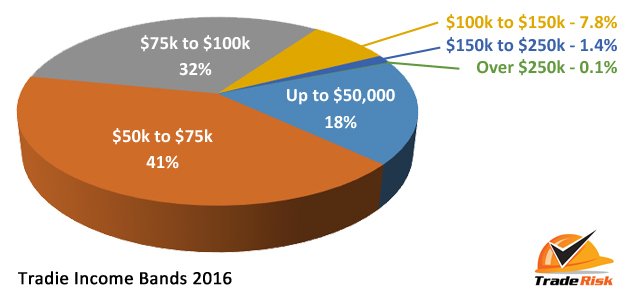This is our 2016 report. To view the current report please click here.
We’re very pleased to release our 2016 report on how much Australian tradies earn.
There is always plenty of talk about the subject, and our previous reports have proven to be very popular.
Here at Trade Risk we are very privileged to see the income figures of thousands of tradies every year, and this is what enables us to put together this report.
The report covers a wide range of building and construction trades from all corners of Australia.
We’ll look at the average incomes for the top 10 trades, and we’ll also look at how they’ve changed from previous years.
Who are the big winners in 2016? Read on to find out…
The Top 10 earning trades
Our biggest finding this year was that the gaps between the top ten trades narrowed significantly.
In previous years this chart featured quite a slope from the highest to lowest earning trades, but this year it is significantly flatter.
Boilermakers lost their place at the top of the list for the first time in our report’s history. They were replaced by electricians, who jumped up from second position.
The big surprise was seeing plumbers drop down the list from third to sixth, behind bricklayers, tilers and plasterers.
Do we really think plumbers are earning less than the three trades in front? It seems unlikely, but we’ve checked the figures and that’s what we have.
It’s worth noting that the reason for the drop is not because plumbers are earning less than previously, but simply because the other trades had larger increases in their average income.
As always there were a small number of trades and occupations that could have featured in the top ten, however the number of entries were considered too low to be statistically accurate.
These included refrigeration mechanics, air conditioning contractors, concreters, earthmovers, riggers, scaffolders and stonemasons.
Comparison to the national average
Our figures show that the average income for a tradie is $76,800. That’s up from $70,500 in our last report and $68,900 prior to that.
The national average income in Australia, according to the ABS, is $78,900.
It’s important to remember that our figures include tradies who are predominantly sole traders and subcontractors, whereas the national average from the ABS will include all sorts of outrageously paid people.
For that reason, just because the tradie average is below the national average, it does not mean that a typical tradie earns less than a typical non-tradie.
Overall income bands
Another interesting metric to look at is how many tradies fall into the different income bands.
As with last year we found that the largest group, making up around 41% of tradies, sits in the $50k to $75k range.
The good news is that the lowest range, up to $50k income, shrunk from 27% to 18%.
The $50k to $75k range expanded slightly from 40% to 41%, and the $75k to $100k range expanded strongly from 27% to 32%.
Ultimately this means that more tradies are earning $50k+ and $75k+ than last year, which is a good thing.
A lucky (or should that be hard working) 9% of tradies made it into six figures.
Keep in mind that these numbers relate to personal income, or basically the profit of the business.
If you still have $100k after paying all of your business expenses you’re doing well!
Conclusion
If you want to earn more than the national average, most of the trades in our top ten list will get you there.
Although the bottom few trades in the top ten have average incomes lower than the national average, it’s important to point out that plenty of those tradies are still doing very well for themselves.
For example although carpenters have an average income lower than the national average, our figures included plenty of chippies with incomes over $100k.
By the same token, the figures also included dozens of electricians and plumbers with income below the national average.
The takeaway here is that although some trades do have higher incomes on average, any tradie can earn a great income if they work hard enough and smart enough.
Want to see the previous reports? Follow the links to our 2014 and 2013 reports.
Important information about the figures
When looking at these figures it’s important to get some background on where they’ve come from.
The typical tradesman client of Trade Risk is a subcontractor or sole trader, often working on their own or with just a few staff.
Whilst there will be some clients running large teams and earning very strong six figure incomes, these are certainly not the norm.
It’s also important to note that the figures are based on personal income declared for income protection. So the figures are based on profit, not turnover.
Some tradies may say they ‘earn’ $100k, but if their business expenses are $25k a year then the figure we take is $75k.
We don’t claim that our figures are 100% accurate and reflect every tradesman across every industry.
But what we can say is that the figures have come from over 2,000 tradies from all states and territories, and based on previous years they appear to be quite consistent across the years.






